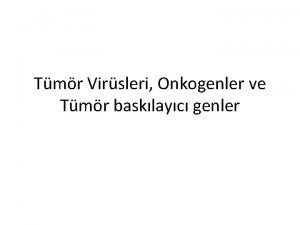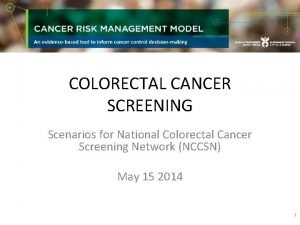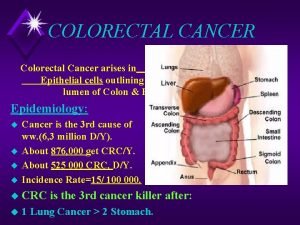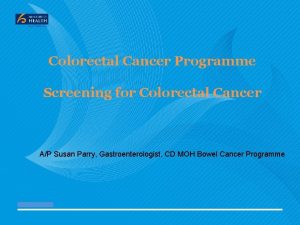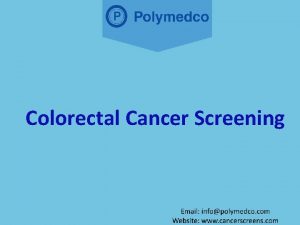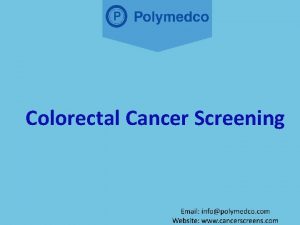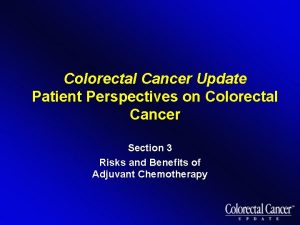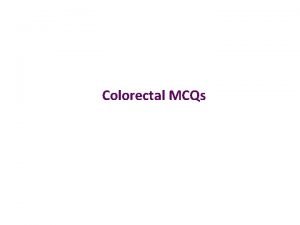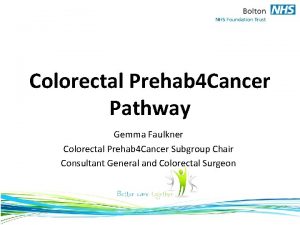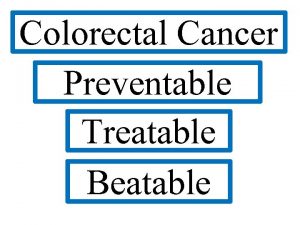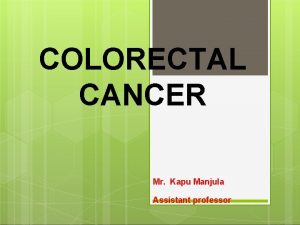Colorectal Cancer Definitio nColorectal Cancer is the cancer





























- Slides: 29

Colorectal Cancer

Definitio n�Colorectal Cancer is the cancer affecting caecum, colon and rectum �Anal canal and Appendix are not considered in the definition, and are treated as a separate entities

DEFINITION COLON CANCER IS A DISEASE IN WHICH ABNORMAL, UNCONTROLE GROWTH OF CELL IN THE LINING OF THE COLORECTAL REGION.

Incidenc e�SECOND most common cause of related deaths in North Cancer America �Estimated new cases and deaths from colon and rectal cancer in the United States in 2009* New cases: 106, 100 (colon); 40, 870 (rectal) Deaths: 49, 920 (colon and rectal combined) *Source – National Cancer Institute

High Risk Factors � Familial Adenomatous Polyposis � Hereditary Non Poliposis Colon Cancer � Family history of Colo Rectal Carcinoma � Previous Colorectal CA, Ovarian, Endometrial, Breast CA* � Age >50 � Inflammatory Bowel Disease (UC > CD) � Poor Diet (increased fat, red meat, decreased fibre) � Smoking � Diabetes mellitus & Acromegaly � Streptococcus Bovis Bacteremia* � Ureterosigmoidostomy* * Harrisons

Familial Factors – Risks for Syndrome Distrubution Histology Malignant Other CRC potential Lesion Familial Large Intestine Adenomatou s Polyposis Common Gardner Syndrom e Turcot Syndrome Large and Adenoma Small Intestine Large Intestine Adenoma Common Nonpolyposi Large Intestine Adenoma s Syndrome Common Peutz Jeghers Syndrome Rare Small, Large Intestine, Stomach Hamartoma Common s none Multiple Malignanci es Brain Tumors Endometri al and Ovarian Tumors Multiple Malignancies

Genetic Changes in CRC MECHANISM - the GENETIC CHANGES �Activation of proto - oncogenes (Kras) �Loss of tumoursuppressor gene activity (APC, DCC) �Abnormalities in DNA repair genes (h. MSH 2, h. MLH 1), mutational activation of an oncogene followed by and coupled with the loss of genes that normally suppress tumorigenesis

Colorectal Polyps

Patho physiology � Due to the E/F ( Age, Alocohol , Smoking) � Chronic exposure to factor Unregulated proliferation & Differentiation of cancer cells in colon � Prolonged inflammation � Genetic mutation of the cellular DNA � Activation of growth promoting oncogenes � De activation of tumor suppressor gene cell Polyps in colon Tumor growth in the colon

TNM STAGES OF CANCER Tumour (T) There are 4 stages of tumour size in bowel cancer: T 1 means the tumour is only in the inner layer of the bowel. T 2 means the tumour has grown into the muscle layer of the bowel wall. T 3 means the tumour has grown into the outer lining of the bowel wall but has not grown through it. T 4 is split into 2 stages, T 4 a and T 4 b: T 4 a means the tumour has grown through the outer lining of the bowel wall and has spread into the tissue layer (peritoneum) covering the organs in the tummy (abdomen) T 4 b means the tumour has grown through the bowel wall into nearby organs

N 0 (N plus zero): There is no spread to regional lymph nodes. N 1 a: There are tumor cells found in 1 regional lymph node. N 1 b: There are tumor cells found in 2 or 3 regional lymph nodes. N 1 c: There are nodules made up of tumor cells found in the structures near the colon that do not appear to be lymph nodes. N 2 a: There are tumor cells found in 4 to 6 regional lymph nodes.

M 0 (M plus zero): The disease has not spread to a distant part of the body. M 1 a: The cancer has spread to 1 other part of the body beyond the colon or rectum. M 1 b: The cancer has spread to more than 1 part of the body other than the colon or rectum.

Signs & Symptoms • A change in bowel habits, such as diarrhea, constipation, or narrowing of the stool, that lasts for more than a few days • A feeling that you need to have a bowel movement that is not relieved by doing so • Rectal bleeding • Dark stools, or blood in the stool • Cramping or abdominal (belly) pain • Weakness and fatigue • Unintended weight loss

Preventio n � Increase fibre in diet � Decrease animal fat and red meat, � Decrease smoking and Et. OH � Increase exercise and decrease BMI � Secondary prevention with screening

Diagnostic Test Digital rectal exam (DRE): most common exam, but not recommended as a screening tool Fecal occult blood test (FOBT): - proper test requires 3 samples of stool - still recommended annually by the World Health Organization (WHO) - results in 16 -33% reduction in mortality in RCTs - Minnesota Colon Cancer Study: RCT showed that annual FOBT can decrease mortality rate by 1/3 in patients 50 -80 years old Sigmoidoscopy: - can identify 30 -60% of lesions -sigmoidoscopy + FOBT misses 24% of colonic neoplasms Colonoscopy: can remove or biopsy lesions during procedure can identify proximal lesions missed by sigmoidoscopy used as follow-up to other tests if lesions found disadvantages: expensive, not always available, poor compliance, requires sedation, risk of perforation (0. 2% Virtual colonoscopy: 91% sensitive, 17% false positive rate Air contrast barium enema: 50% sensitive for large (>1 cm) adenomas, 39% for

Screening - Canadian Guidelines

Investigatio ns. Colonoscopy (best), look for � synchronous lesions - Alternative: air contrast barium enema (“apple core” lesion) + sigmoidoscopy � If a patient is FOBT +ve, microcytic anemia or has a change in bowel habits, do colonoscopy � Metastatic workup: CXR, abdominal CT/ultrasound �Bone scan, CT head only if lesions suspected � Labs: CBC, urinalysis, liver function tests, CEA (before surgery baseline)

Barium Enema

Sigmoidosco py

Colonoscop y

Capsule (Colonoscopy)

Capsule Endoscopy

Virtual Endoscopy

Virtual Colonoscopy

Ulcerating Carcinoma

Treatmen t SURGERY (indicated in potentially curable or symptomatic cases - not always in stage IV) � Curative: wide resection of lesion (5 cm margins) with nodes and mesentery � Palliative: if distant spread, then local control for hemorrhage or obstruction � 80% of recurrences occur within 2 years of resection � Improved survival if metastasis consists of solitary hepatic mass that is resected � Colectomy: - most patients get primary anastomosis (e. g. hemicolectomy, low anterior resection (LAR)- if cancer is below levators in rectum, patient may require an abdominal perineal resection (APR) with a permanent end colostomy, especially if lesion involves the sphincter complex - complications: anastomotic leak or stricture, recurrent disease, pelvic abscess, enterocutaneous fistula RADIOTHERAPY & CHEMOTHERAPY � Chemotherapy (5 FU based regimens): for patients with node-positive disease � Radiation: for patients with node-positive or transmural rectal cancer (pre ± post-op), not effective in treatment of colon cancer � Adjuvant therapy – chemotherapy (colon) and radiation (rectum) � Palliative chemotherapy/radiation therapy for improvement in symptoms and survival

Local Excision, Resection Anastomosis

Resection and Colostomy

NURSING MANAGEMENT • Diarrhea and constipation related to altered bowel elimination patterns • Acute pain related to difficulty in passing stools because of partial or complete obstruction of tumor • Fear and anxiety related to diagnosis of tumor and surgical procedure. • Imbalanced Nutrition less than body requirement related to less intake.
 Colorectal cancer drug trial
Colorectal cancer drug trial Sorunun cevabını bul
Sorunun cevabını bul Amsterdam 2 criteria
Amsterdam 2 criteria Hnpcc
Hnpcc Ann lyons colorectal surgeon
Ann lyons colorectal surgeon Công thức tính thế năng
Công thức tính thế năng Thế nào là mạng điện lắp đặt kiểu nổi
Thế nào là mạng điện lắp đặt kiểu nổi Sự nuôi và dạy con của hổ
Sự nuôi và dạy con của hổ Các châu lục và đại dương trên thế giới
Các châu lục và đại dương trên thế giới Dot
Dot Biện pháp chống mỏi cơ
Biện pháp chống mỏi cơ Bổ thể
Bổ thể Phản ứng thế ankan
Phản ứng thế ankan Thiếu nhi thế giới liên hoan
Thiếu nhi thế giới liên hoan Hát lên người ơi
Hát lên người ơi điện thế nghỉ
điện thế nghỉ Một số thể thơ truyền thống
Một số thể thơ truyền thống Trời xanh đây là của chúng ta thể thơ
Trời xanh đây là của chúng ta thể thơ Hệ hô hấp
Hệ hô hấp So nguyen to
So nguyen to Tỉ lệ cơ thể trẻ em
Tỉ lệ cơ thể trẻ em Phối cảnh
Phối cảnh đặc điểm cơ thể của người tối cổ
đặc điểm cơ thể của người tối cổ Các châu lục và đại dương trên thế giới
Các châu lục và đại dương trên thế giới ưu thế lai là gì
ưu thế lai là gì Các môn thể thao bắt đầu bằng tiếng nhảy
Các môn thể thao bắt đầu bằng tiếng nhảy Tư thế ngồi viết
Tư thế ngồi viết Cái miệng nó xinh thế
Cái miệng nó xinh thế Hình ảnh bộ gõ cơ thể búng tay
Hình ảnh bộ gõ cơ thể búng tay Cách giải mật thư tọa độ
Cách giải mật thư tọa độ

